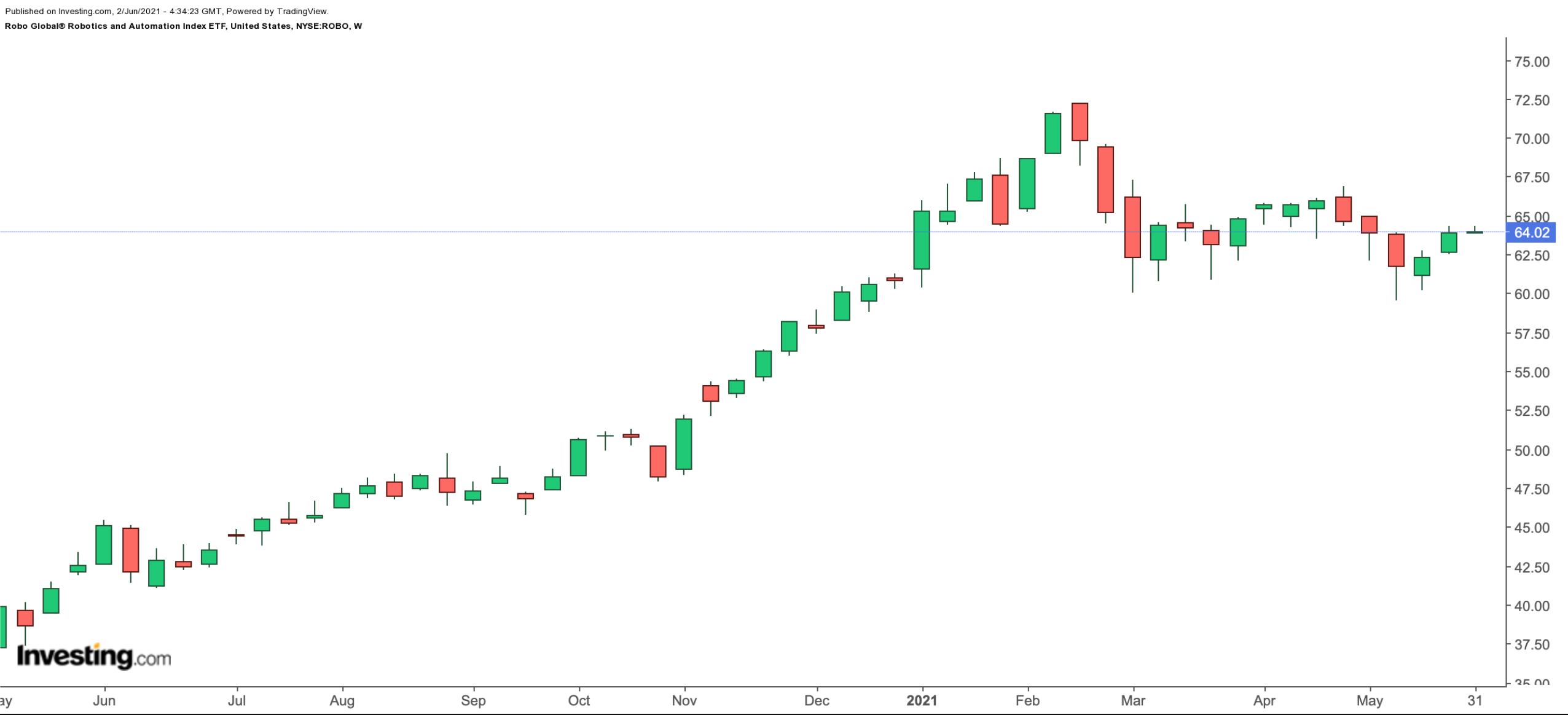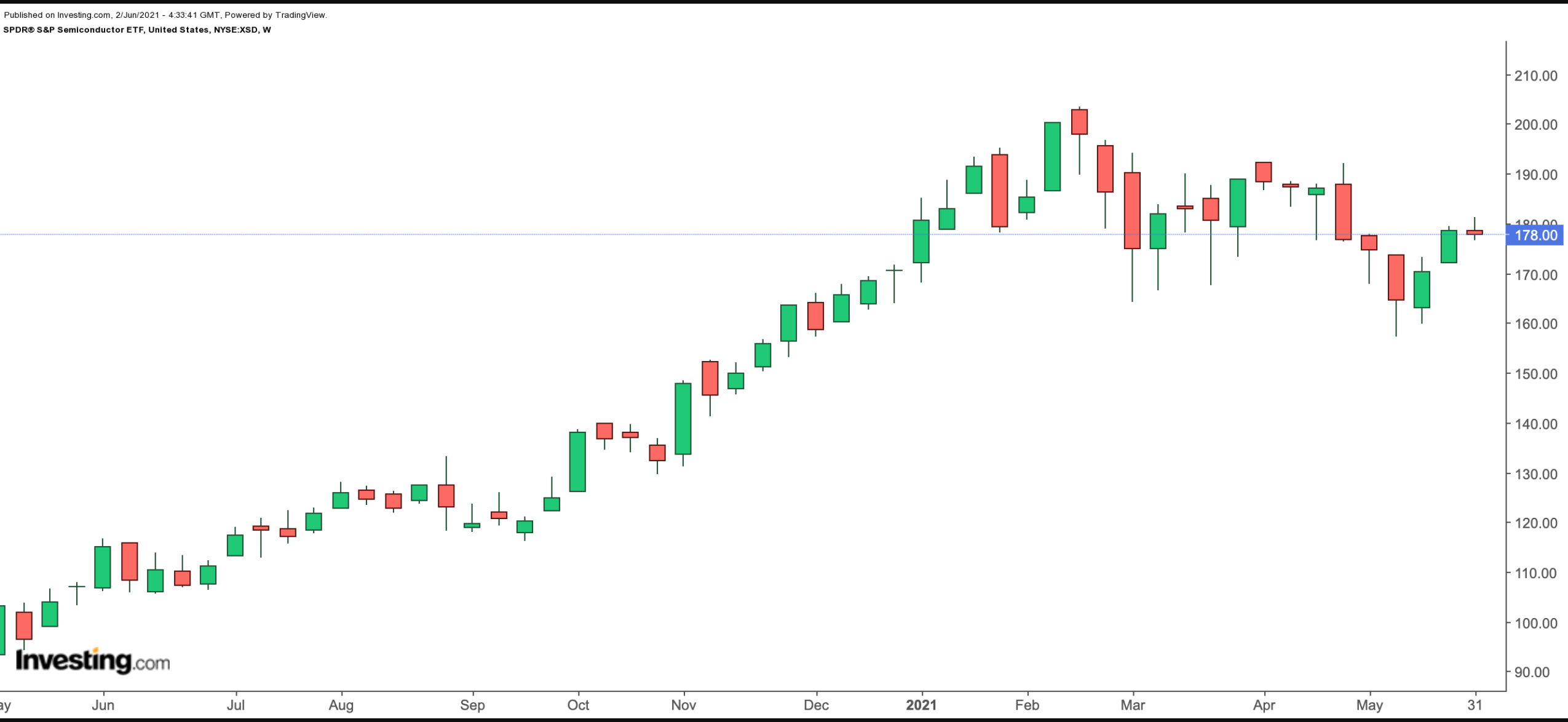Many of Wall Street’s tech darlings have taken a breather recently. Having hit multi-year highs in the last number of weeks, tech shares and exchange-traded funds (ETFs) have given up some of their gains.
We recently covered exchange-traded funds (ETFs) that performed well in May, so today we are looking at two technology ETFs that could potentially rebound in the coming weeks.
1. ROBO Global Robotics and Automation Index ETF
Current Price: $64.02
52-Week Range: $41.10 - $72.28
Dividend Yield: 0.19%
Expense Ratio: 0.95% per year
The pandemic meant a significant uptick in the need to automate and digitalize. From self-driving cars to automation at home and in the workplace, the number of robotic units manufactured is increasing fast.
Grand View Research highlights:
“The global robotic process automation market size was valued at US$1.57 billion in 2020 and is expected to grow at a compound annual growth rate (CAGR) of 32.8% from 2021 to 2028.”
Therefore, our first fund could be of interest to readers who are following these trends. The Robo Global® Robotics and Automation Index ETF (NYSE:ROBO) is one of the first robotics and automation ETFs on Wall Street. Since its inception in October 2013, net assets have grown close to $1.8 billion.

ROBO, which provides exposure to global companies that are engaged in robotics, automation and artificial intelligence (RAAI), has 84 holdings. The top 10 names comprise about 17% of the fund.
Brooks Automation (NASDAQ:BRKS), which provides solutions for the semiconductor and life sciences segments; robotic surgery systems innovator Intuitive Surgical (NASDAQ:ISRG); Swiss storage and materials handling systems group Kardex (SIX:KARN); Sweden-based Hexagon (OTC:HXGBY), which provides information technologies for geospatial applications; and conversational artificial intelligence company Nuance Communications (NASDAQ:NUAN) are among the leading stocks.
Manufacturing and industrials have the largest sectoral weighting in the fund with 15%. They are followed by computing and AI (14%), information technology (13.37%) and health care (12%) firms. In terms of country allocations, the U.S. heads the list with 47%, followed by Japan (20%) and Germany (7%).
Over the past year, ROBO has returned almost 50% and hit an all-time high in mid-February. Since then, it has trimmed about 11% of the gains. Yet, year-to-date, the fund is still up close to 5%.
Given the importance of automation, we’re bullish on the ETF and would regard any further decline toward $60 an opportunity to go long ROBO.
2. SPDR® S&P Semiconductor ETF
Current Price: $178
52-Week Range: $104.13 - $203.60
Dividend Yield: 0.29%
Expense ratio: 0.35% per year
Semiconductor shares have recently come under pressure, in part due to the global chip shortage. So far this year, the widely followed Philadelphia Semiconductor Index is up about 13% and hit an all-time high in early April. But since then, the index has given up some of those annual returns.
Technological advances and secular trends are critical to long-term investment strategies. The semiconductor industry designs and manufactures chips that other businesses rely on to bring new products and technologies to the market.
According to the Semiconductor Industry Association, “worldwide sales of semiconductors totaled $123.1 billion during the first quarter of 2021, an increase of 3.6% over the previous quarter and 17.8% more than the first quarter of 2020.”
The SPDR® S&P Semiconductor ETF (NYSE:XSD) is an equal-weighted fund. It gives access to 38 semiconductor shares across a range of market capitalizations. We previously discussed the importance of equal-weighted ETFs for long-term portfolios.

XSD, which tracks the returns of the S&P Semiconductors Select Industry, began trading in January 2006. The top 10 names comprise close to 30% of net assets of $912 million.
Chip giants Nvidia (NASDAQ:NVDA) and Texas Instruments (NASDAQ:TXN); Lattice Semiconductor (NASDAQ:LSCC), which has a market cap of $7.2 billion; Maxim Integrated Products (NASDAQ:MXIM), which focuses on analog circuits; and NXP Semiconductors (NASDAQ:NXPI), which is headquartered in the Netherlands; make up the top names in the roster.
Over the past 12 months, XSD has returned more than 70%. However, YTD, it is up about 4.5%. In the case of further weakness in tech shares, a decline below $175 is possible.
Potential investors should regard such a drop in price as an opportunity to invest in XSD. We like the diversity of the names with a range of market caps. However, we should remind readers that the volatility of the fund is high. Therefore, it should ideally be a supplementary part of a long-term portfolio.
